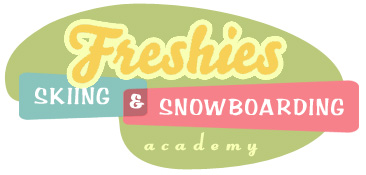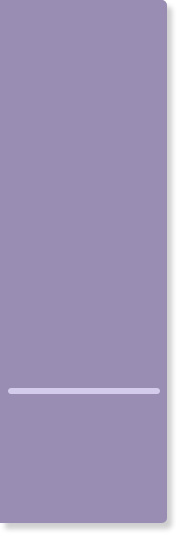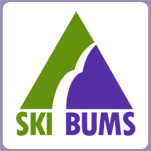
Teach me some lingo!
Here's a basic rundown of common skiing and snowboarding vocabulary. This isn't slang,
good Freshies academy students, this is vocab. Although there are good places for words
like sick, gnarly and jib, what follows are words that you'll hear 60-year old slope
veterans using on the chair lift, so don't fear that you're not rad enough to use them. :)
Types of Runs
Bunny Hill - the area of any ski mountain that’s specifically set aside for beginners. It’s
always got a very slight incline, and lots of extra room for everyone to fall down without
any worries.
Backcountry - the unmarked trails that are beyond the areas of the mountain that are
accessible by the lifts. Only the most expert skiers and riders should ever explore
backcountry areas. They go through extensive avalanche survival training, and carry
special gear. If you’re the sort of skier or rider who’s reading this vocabulary list, don’t go
into the backcountry.
Groomed run (or “groomer”) - a run that’s been combed over by grooming
equipment, resulting in a smooth, wavy surface that some folks will call corderoy. A
groomed surface is the easiest surface to ski or ride on. Most grooming is done overnight,
so the best time to enjoy groomed runs is early in the day.
Bowl -- a large, open, bowl-shaped area of a mountain, usually with few trees and lots of
snow. More common out West than in the East.
Mogul run - a run that’s got big bumps, which are particularly challenging. Sometimes
these bumps are the natural byproduct of a fresh snowfall that’s been churned up by a
day or two of skiers and riders, and sometimes they’re moguls that are shaped by special
equipment. Most mogul runs are black diamond runs.
Chutes - extremely challenging trails that dodge between trees or rocks, usually at the
top of a mountain. These are often marked with double-black diamonds.
Cat tracks - a very thin trail that cuts across a mountain, usually connecting one part of
the mountain to another, with a very slight incline. Snowboarders often dislike them,
because the slight incline makes it difficult to maintain speed.
Traverse - verb: to ski or slide-slip against the fall line, to move sideways across a
slope, instead of down. If you suddenly discover a field of moguls below you, you might
traverse across the slope to get to an easier area of the run. noun: a path that cuts
sideways across a slope.
What's a Line?
Lift line - the line of people waiting to board a chair lift.
Fall line - the imaginary line down the natural slope of a trail: if you allowed a big ball to
roll down a hill, that’s the fall line.
Line - the particular path that you take down a run, most often used when skiing or riding
in an open bowl. Skier 1: “I’m going to head out left, then head straight down.” Skier 2:
“Yeah, that’s a great line.”
Types of Snow
Many skiers and boarders who are accustomed to icy, crusty East Coast slopes haven't
discovered that there are many different types of snow, and your equipment will respond
very differently, based on the snow type. Learning the types of snow helps you know
what you'll enjoy when you're deciding which runs to take. At the top, you can ask a
guide, "How's the Prospector run today?" They'll reply, "It's mostly crud, with mashed
potatoes at the bottom. The Gold Mine run is all corn, though." Read on to know what
they're saying!
Powder - fresh snowfall that's low in moisture content. Powder is the best snow to ski or
ride on. In the West, some resorts (particularly in Utah) have fluffy powder with
extremely low moisture content, which they'll call champagne powder.
Crud - powder that’s been skied over. It looks like cookie dough; it's chunky looking, but
still soft. Crud is a preferred snow texture.
Corn - hard re-frozen pellets of snow - a preferred snow texture.
Grapple - like very small hail pellets, or like sleet, but rounder and thicker. Grapple isn't
the best snow, but it's not the worst. It doesn't stick to your skis or board.
Groomed - see "groomed run" above.
Crust - hard packed snow that's frozen, but not icy.
Dust on crust - a small amount of fresh powder snowfall, but crust underneath. This
snow texture is the most notorious for causing you to fall; your edges can easily slip when
you hit a bare patch of crust.
Mashed Potatoes - warm, melting snow, most common during the spring at the base of
a mountain. It's notoriously slow to ski or ride in.
Sierra cement - Wet, heavy snow, which is common in the Sierra Mountain range -
Lake Tahoe, for example - but frozen and still cold. Unlike mashed potatoes, sierra
cement isn't melting.
Types of Conditions
Bluebird day - The most gorgeous day imaginable. A bluebird day is a bright, sunny day
after a fresh snowfall the night before.
Vertigo - foggy conditions, which make it very easy to lose your sense of balance.
Flatlight - a cloudy day, which makes it hard to perceive definition on the snow surface,
and can easily trigger a headache. A yellow-lens goggle will often help the best.
Read more articles...












Copyright 2006, SKI BUMS.

